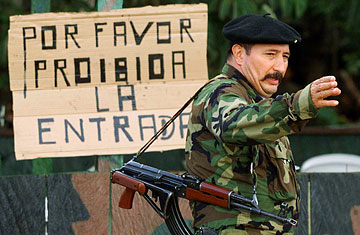
Colombian guerrilla leader Jorge Briceño, known as Mono Jojoy, gives orders in La Macarena in this file photo taken June 27, 2001
On Sept. 1, Colombia's Marxist guerrillas detonated 1,400 lb. (635 kg) of TNT near the southern town of El Doncello. The blast killed 14 policemen, placing them among the 40 government troops who have lost their lives in rebel ambushes this month. The carnage seemed to signal that the Revolutionary Armed Forces of Colombia, or FARC, was gaining a second wind after a string of crushing defeats. To rally the troops, new President Juan Manuel Santos last week flew to the conflict zone. "The FARC is a mouse that uses terrorism to try to roar like a lion," Santos told police and army soldiers at the sprawling military base in Florencia. "And we are going to keep after that mouse until it no longer breathes."
On Wednesday, Sept. 22, the Colombian military took a huge step toward strangling the rodent when it killed Jorge Briceño, the FARC's No. 2 leader, who goes by the alias Mono Jojoy. In a predawn raid in La Macarena, a region 200 miles (320 kg) south of Bogotá, Colombian air-force planes bombed Briceño's elaborate jungle camp, which had been outfitted with concrete bunkers and escape tunnels, killing Briceño before Colombian special forces moved in and gunned down 20 more guerrillas. "This is a day of joy and glory for all of Colombia," Defense Minister Rodrigo Rivera said. Santos called it the biggest blow to the FARC since the rebels took up arms in the 1960s.
For most Colombians, the burly, mustachioed Briceño, who always wore a Che Guevara–style black beret, symbolized a dark and desperate period. In the late 1990s and early 2000s, Briceño planned a string of attacks on poorly defended southern towns and military bases, in which the rebels captured and killed hundreds of government troops. He was also a driving force behind the FARC's decision to kidnap Colombian politicians with the intent of swapping them for imprisoned guerrillas. Looking like a corrupt prison warden, Briceño was filmed in 2001 lording over scores of hostages penned in jungle concentration camps. Keith Stansell, one of three U.S. military contractors held for five years (2003-08) by the FARC, sarcastically referred to him as "the great and magnificent Mono Jojoy."
Amid a long-running, U.S.-backed military campaign, Stansell and most of the other FARC hostages have been freed, while the rebels have seen their numbers cut in half, to about 8,000 fighters. Now, with the death of the 57-year-old Briceño, the FARC has lost four of the seven members of its ruling secretariat in the past two years. "Mono Jojoy spent all his life in the FARC," says Bogotá political analyst Armando Borrero. "He was a historic figure. That makes him irreplaceable."
